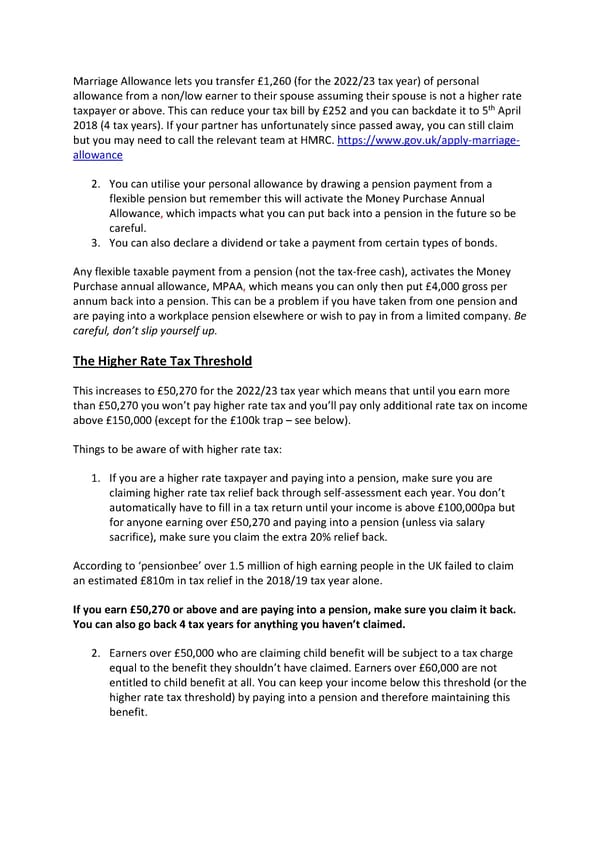Marriage Allowance lets you transfer £1,260 (for the 2022/23 tax year) of personal allowance from a non/low earner to their spouse assuming their spouse is not a higher rate th taxpayer or above. This can reduce your tax bill by £252 and you can backdate it to 5 April 2018 (4 tax years). If your partner has unfortunately since passed away, you can still claim but you may need to call the relevant team at HMRC. https://www.gov.uk/apply-marriage- allowance 2. You can utilise your personal allowance by drawing a pension payment from a flexible pension but remember this will activate the Money Purchase Annual Allowance, which impacts what you can put back into a pension in the future so be careful. 3. You can also declare a dividend or take a payment from certain types of bonds. Any flexible taxable payment from a pension (not the tax-free cash), activates the Money Purchase annual allowance, MPAA, which means you can only then put £4,000 gross per annum back into a pension. This can be a problem if you have taken from one pension and are paying into a workplace pension elsewhere or wish to pay in from a limited company. Be careful, don’t slip yourself up. The Higher Rate Tax Threshold This increases to £50,270 for the 2022/23 tax year which means that until you earn more than £50,270 you won’t pay higher rate tax and you’ll pay only additional rate tax on income above £150,000 (except for the £100k trap – see below). Things to be aware of with higher rate tax: 1. If you are a higher rate taxpayer and paying into a pension, make sure you are claiming higher rate tax relief back through self-assessment each year. You don’t automatically have to fill in a tax return until your income is above £100,000pa but for anyone earning over £50,270 and paying into a pension (unless via salary sacrifice), make sure you claim the extra 20% relief back. According to ‘pensionbee’ over 1.5 million of high earning people in the UK failed to claim an estimated £810m in tax relief in the 2018/19 tax year alone. If you earn £50,270 or above and are paying into a pension, make sure you claim it back. You can also go back 4 tax years for anything you haven’t claimed. 2. Earners over £50,000 who are claiming child benefit will be subject to a tax charge equal to the benefit they shouldn’t have claimed. Earners over £60,000 are not entitled to child benefit at all. You can keep your income below this threshold (or the higher rate tax threshold) by paying into a pension and therefore maintaining this benefit.
 Use it or Lose it - Tax Year End Planning 2023 Page 2 Page 4
Use it or Lose it - Tax Year End Planning 2023 Page 2 Page 4